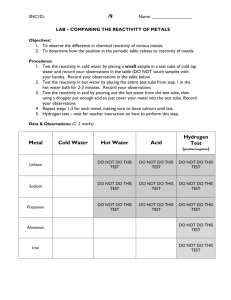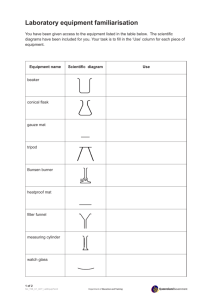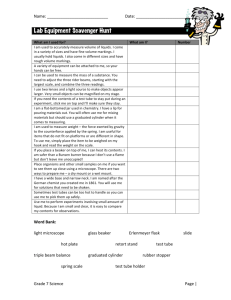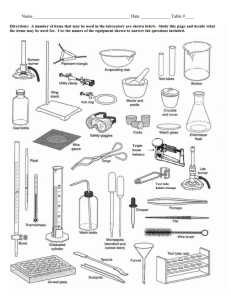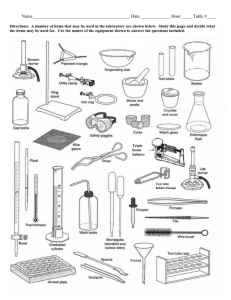WORD - colgur chemistry
advertisement
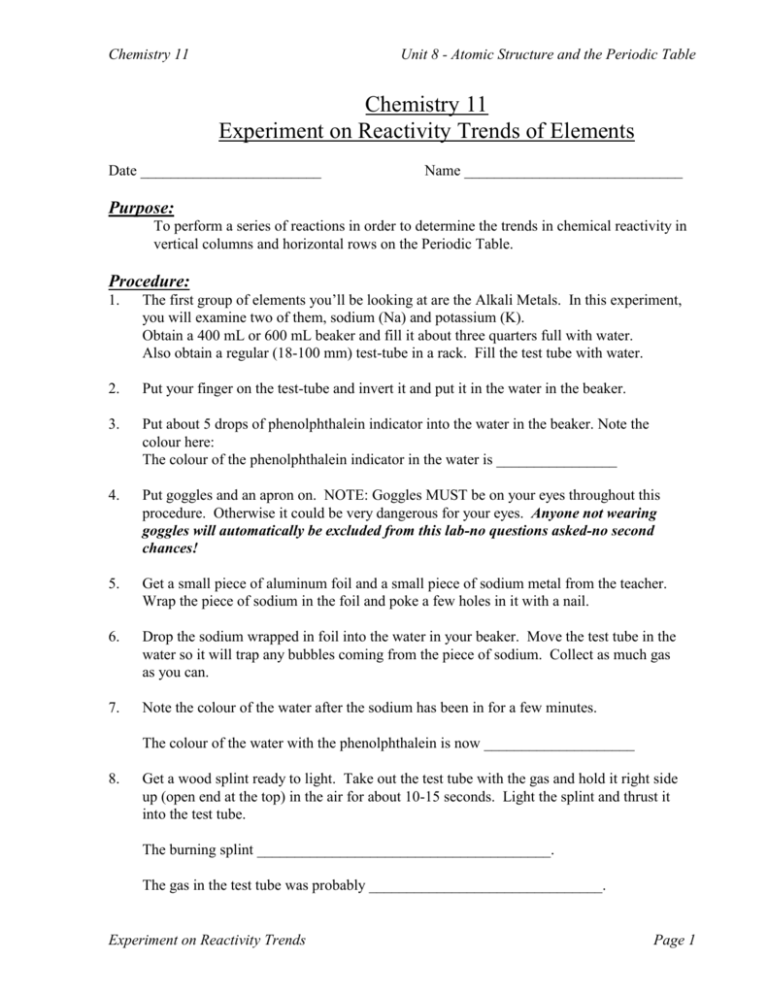
Chemistry 11 Unit 8 - Atomic Structure and the Periodic Table Chemistry 11 Experiment on Reactivity Trends of Elements Date ________________________ Name _____________________________ Purpose: To perform a series of reactions in order to determine the trends in chemical reactivity in vertical columns and horizontal rows on the Periodic Table. Procedure: 1. The first group of elements you’ll be looking at are the Alkali Metals. In this experiment, you will examine two of them, sodium (Na) and potassium (K). Obtain a 400 mL or 600 mL beaker and fill it about three quarters full with water. Also obtain a regular (18-100 mm) test-tube in a rack. Fill the test tube with water. 2. Put your finger on the test-tube and invert it and put it in the water in the beaker. 3. Put about 5 drops of phenolphthalein indicator into the water in the beaker. Note the colour here: The colour of the phenolphthalein indicator in the water is ________________ 4. Put goggles and an apron on. NOTE: Goggles MUST be on your eyes throughout this procedure. Otherwise it could be very dangerous for your eyes. Anyone not wearing goggles will automatically be excluded from this lab-no questions asked-no second chances! 5. Get a small piece of aluminum foil and a small piece of sodium metal from the teacher. Wrap the piece of sodium in the foil and poke a few holes in it with a nail. 6. Drop the sodium wrapped in foil into the water in your beaker. Move the test tube in the water so it will trap any bubbles coming from the piece of sodium. Collect as much gas as you can. 7. Note the colour of the water after the sodium has been in for a few minutes. The colour of the water with the phenolphthalein is now ____________________ 8. Get a wood splint ready to light. Take out the test tube with the gas and hold it right side up (open end at the top) in the air for about 10-15 seconds. Light the splint and thrust it into the test tube. The burning splint _______________________________________. The gas in the test tube was probably _______________________________. Experiment on Reactivity Trends Page 1 Chemistry 11 9. Unit 8 - Atomic Structure and the Periodic Table Empty the water and rinse out the beaker several times with tap water. 10. Refill the beaker about 3/4 full of fresh tap water. Put about 5 drops of phenolphthalein indicator into the beaker. 11. Obtain a square ceramic gauze pad. 12. With goggles and apron on, get a piece of paper towel and obtain a small piece of potassium (K) from the teacher. Wipe the oil off the potassium with the paper towel. 13. Make sure there is nobody close to your beaker! Check to make sure goggles are on! Have the square gauze pad ready! Standing well back, carefully put the piece of potassium in the water and QUICKLY place the gauze pad on top of the beaker. Describe the reaction: __________________________________________________ ___________________________________________________________________ Would you say that potassium is more reactive or less reactive than sodium? _____ 14. Using the periodic table, predict whether rubidium would be more reactive or less reactive than potassium. _____________________________________________ 15. Which would be the least reactive of the alkali metals? _______________ 16. Which would be the most reactive of the alkali metals? ______________ ************************************************ Next, you’ll be observing two more elements in the fourth horizontal row (period of the periodic table ************************************************ 17. Rinse out your beaker a few times and refill it with about 3/4 full of fresh tap water. Also obtain a regular (18-100 mm) test-tube in a rack. Fill the test tube with water. 18. Put your finger on the test-tube and invert it and put it in the water in the beaker. 19. Put about 10 drops of phenolphthalein indicator into the water in the beaker. Note the colour here: The colour of the phenolphthalein indicator in the water is ________________ Experiment on Reactivity Trends Page 2 Chemistry 11 Unit 8 - Atomic Structure and the Periodic Table 20. Put goggles and an apron on. NOTE: Goggles MUST be on your eyes throughout this procedure. Otherwise it could be very dangerous for your eyes. 21. Get a small piece of calcium metal from the teacher 22. Drop the calcium into the water in your beaker. Move the test tube in the water so it will trap any bubbles coming from the piece of calcium. Collect as much gas as you can. Describe the reaction of Calcium with water: ________________________________ ____________________________________________________________________ 23. Note the colour of the water after the calcium has been in for a few minutes. The colour of the water with the phenolphthalein is now ______________________ 24. Get a wood splint ready to light. Take out the test tube with the gas and hold it right side up (open end at the top) in the air for about 10-15 seconds. Light the splint and thrust it into the test tube. The burning splint ___________________________________________. The gas in the test tube was probably ___________________________________. 25. Empty the water and rinse out the beaker several times with tap water. 26. Does calcium appear to be more or less reactive that potassium? ______________________ 27. Next, refill the beaker about 3/4 full of fresh tap water. Now place a small piece of Copper (Cu) wire in the water and note what happens: ________________________________________________________________________ Is copper more or less reactive than calcium? ______________________________ 28. The third period of the periodic table looks like: K Ca Sc Ti V Cr Mn Fe Co Ni Cu Zn Ga Ge As Se Br Kr Based on the results of procedures 13, 22 and 27, what is the trend in chemical reactivity as you go from the left side towards the middle of the periodic table in one period (row)? As you move from left towards the middle, the reactivity ______________________ Experiment on Reactivity Trends Page 3 Chemistry 11 Unit 8 - Atomic Structure and the Periodic Table Demonstration The next procedures will be DEMONSTRATED by the TEACHER since they involve more dangerous and toxic elements. Record results on this paper. The following demonstration involves the vertical column (Group) 17 or the Halogens: ************************************************ 29. When the element aluminum is put into solution of iodine, is there an obvious reaction?__ 30. When the element aluminum is put into a beaker containing bromine, describe the reaction: ____________________________________________________________________ ____________________________________________________________________ What would the product of this reaction be? 31. _____________________________ On the basis of the last two observations, do you think chlorine would be more reactive or less reactive than bromine? _____________________________________ What happens to the reactivity of the halogens as you move down the column? ____________________________________________________________________ Is this the same trend as the alkali metals? ______________________________ 32. Which do you think is more reactive, nitrogen or fluorine? Give a reason for your answer. ___________ ____________________________________ ______________________________________________________________ 33. Predict what happens to the reactivity of non-metals as you move from the middle toward the right side of the periodic table within a period. (ie. from C N F). _____________________________________________________________________ 34. What can you say about the reactivity’s of noble gases? _____________________ __________________________________________________________________ Experiment on Reactivity Trends Page 4 Chemistry 11 Unit 8 - Atomic Structure and the Periodic Table Explain why their reactivity is like this on the basis of their electron arrangements. _______________________________________________________ ______________________________________________________________ Questions 1. In summary: The reactivity of metals __________________________ as you move down a vertical column. The reactivity of non-metals _____________________ as you move down a vertical column. The reactivity within a period (horizontal row) as you move toward the centre and as you move toward either end. 2. __________________ ______________________________ It is known that the pink colour in phenolphthalein indicator means that hydroxide (OH-) ions are present. When sodium reacts with water, the sodium atom loses an electron to become the Na+ ion, which is much more stable than Na atoms. Na+ ions and OH- ions form the compound _______________. The gas formed when sodium is put into water is __________________ gas. 3. Write the balanced formula equation for the reaction of sodium with water. _____________________________________________________________________ 4. Write the balanced formula equation for the reaction of potassium with water. _____________________________________________________________________ 5. Write the balanced equation for the reaction of aluminum with bromine. _____________________________________________________________________ 6. Write the balanced equation for the reaction of aluminum with chlorine. ___________________________________________________________________ Experiment on Reactivity Trends Page 5
